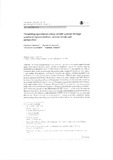| dc.contributor.author | Lemonakis, Christos | |
| dc.contributor.author | Sariannidis, Nikolaos | |
| dc.contributor.author | Garefalakis, Alexandros | |
| dc.contributor.author | Adamou, Anastasia | |
| dc.date.accessioned | 2022-01-22T09:36:28Z | |
| dc.date.available | 2022-01-22T09:36:28Z | |
| dc.date.issued | 2020-11 | |
| dc.identifier.issn | 0254-5330 | |
| dc.identifier.uri | http://hdl.handle.net/11728/12119 | |
| dc.description.abstract | The ever-changing business environment, coupled with increased competition and rapid technological advances, exert pressure on businesses looking for modern ways of production and operation, based on their survival and success in profitability. In order to strengthen their market position and ultimately to gain competitive advantage over others, a large number of companies—perhaps the majority—at a global level have installed or are in the process of adopting Enterprise Resource Planning—ERPs Systems. ERPs reorganize business practices and enhance the processes of business units. Changes that ERPs bring to businesses have significant effects on Management Accounting and Internal Audit but also on Accountants and Internal Auditors who are often asked to adapt their methods and techniques to the requirements of new IT systems. This paper looks for findings from previous research in the field, research conducted on possible changes in Administrative Accounting and Internal Control and depends on the effectiveness of ERP systems. In this study, the research interest is focused on the identification, recording and understanding of critical dimensions and factors for the effective implementation of ERPs in firms through their adoption and effective use. There is a theoretical framework for clarifying some terms useful for a better understanding of key issues discussed below. It also demonstrates the international trends and prospects of ERP systems as well as the issues encountered in their effective implementation while presenting the research methodology used, the conclusions and finalizing this chapter with proposals for future research. | en_UK |
| dc.language.iso | en_US | en_UK |
| dc.publisher | Springer Verlag | en_UK |
| dc.relation.ispartofseries | Annals of Operations Research;vol. 294, no. 1, pp. 401-418, 2020 | |
| dc.rights | © Springer Science+Business Media, LLC, part of Springer Nature 2018 | en_UK |
| dc.rights.uri | http://creativecommons.org/licenses/by-nc-nd/4.0/ | en_UK |
| dc.source.uri | https://link.springer.com/article/10.1007/s10479-018-2851-x | en_UK |
| dc.subject | Research Subject Categories::SOCIAL SCIENCES::Business and economics | en_UK |
| dc.subject | ERP systems | en_UK |
| dc.subject | Administrative Accounting | en_UK |
| dc.subject | Internal Control | en_UK |
| dc.title | Visualizing operational effects of ERP systems through graphical representations: current trends and perspectives | en_UK |
| dc.type | article | en_UK |
| dc.doi | 10.1007/s10479-018-2851-x | en_UK |


